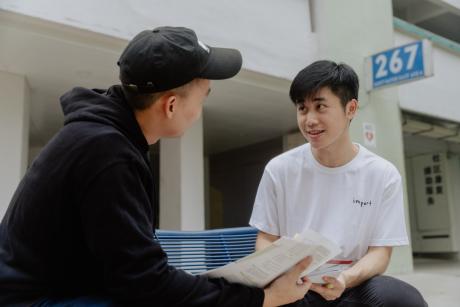By Rob John
Giving to charity has never been a solitary activity in any culture. People have joined together to give for millennia. In Asia, clan associations, religious groups or just friends have enjoyed the benefits of giving as a group. But there appears to be a renaissance of collective giving with the advent of more organised, strategic and outcome-focused philanthropy. At the Asia Centre for Social Entrepreneurship and Philanthropy (ACSEP) where I am presently based, our research team’s curiosity about giving circles was first piqued when investigating the nature of innovation in Asian philanthropy in 2012.1 In that study, we reported several initiatives where individuals pooled their resources and jointly selected a non-profit organisation to fund. Since then, the number and variety of giving circle models have increased across the region, leading me to believe that giving circles will contribute significantly to the development of philanthropy in Asia over the coming decade.
Giving Circles in North America
Giving circles are presently a well-established phenomenon in contemporary American philanthropy. Since the mid- 1990s, their numbers have grown, especially through networked circles such as Social Venture Partners (SVP), The Women’s Collective Giving Grantmakers Network and Impact 100.2 Studies of US giving circles generally support the view that they are more than a fundraising tool, but also an opportunity for individuals to learn more about giving, non-profits and social needs in their own communities. Most giving circle models require individuals to donate quite modest sums and engage their members more deeply than casual “donation tin” or “chequebook” giving. This engagement and the multiplied resources of pooled funds can approach the level of philanthropy more often associated with wealthy individuals or managed charitable funds.
Angela M. Eikenberry, an academic at the University of Nebraska who has extensively studied giving circles, calls them “a transformation in the way we [ordinary citizens] are attempting to address community problems through giving and volunteering”. Her definition of a giving circle remains a helpful starting point in understanding why they are an important innovation in Asia.
Giving circles are hard to define, are flexible in form and nature, but typically exhibit five major characteristics— they pool and give away resources, educate members about philanthropy and issues in the community, include a social dimension, engage members, and maintain their independence. While the most obvious characteristic of a giving circle is syndication—the pooling of capital to make larger donations—we know from research that a giving circle also engages its members to release human capital and provides a learning experience that solitary giving does not.
A survey of 341 members of 26 giving circles supported the assertion that participation had a positive impact on individuals’ philanthropic and civic engagement. Giving-circle members gave more time and money and in a more focused and strategic way compared to those who did not give collectively. The members’ knowledge of philanthropy, non-profit organisations, and problems in their community also increased as a result of giving with others.4 On the American landscape, it appears that gender is a major factor in the formation and dynamics of giving circles: one study revealed that 44 per cent of circles were composed of women only, with two per cent being exclusively male.5 Many US giving circles are hosted by other philanthropic organisations, usually community foundations, which enable circles to offer their members tax exemptions without having to independently file for charitable status. In addition, a few giving circle networks in North America have opened chapters internationally, or inspired others to adapt their model and form circles in Asia.
The Asian Context
The 34 nations and special administrative regions that constitute Asia form a diverse and complex patchwork of cultures, languages, political systems and economies spread across vast distances. In the US and much of Europe, philanthropy is relatively well developed: there is a robust regulatory environment for charitable giving and taxation, and a considerable body of academic research on philanthropy and its place in civic engagement and culture. Ancient traditions of charitable giving, such as the clan associations of 19th-century Chinese migrant traders, have existed for centuries in Asia. In 1915, 23 women formed the Singaporean Chinese Ladies Association. Most were the wives of wealthy business leaders, and together they pursued health and education projects amongst the island’s disadvantaged. Several of the Association’s presidents were to become instrumental in establishing some of Singapore’s most respected grant-making foundations, such as the Tan Foundation, Cathay Organisation and Lee Foundation.
The concept, however, of organised philanthropy in order to effect specific societal benefit is relatively new, emerging from post-colonial wealth creation and private foundations. These relatively new expressions of philanthropy are developing rapidly—even in countries like China, which has no modern tradition of institutional philanthropy. Despite the comparatively less robust and underdeveloped philanthropy “ecosystem” in Asia today, there are many indications that organised, strategic philanthropy will boom in the next decade: we are seeing an increased interest from middleand higher-income earners in a more engaged approach that adds value and is focused on efficiency and results.7 The transfer of family business and associated philanthropy to a new generation of foreign-educated children is one driver of this evolution from traditional giving to more intentional, professionalised familybased philanthropy. In this context of rapidly evolving philanthropy in Asia, models of collective giving are likely to play an influential role, as individuals and communities seek to maximise the impact of their donations and deepen their experience of giving by learning from one another.
Giving Circles in Asia
In the first attempt to map their growth in the region, my 2014 study identified 37 giving circles in Asia,8 which I broadly categorised as either “transplanted” or “indigenous” giving circles.
Transplanted Giving Circles
These models can trace their origins to a network outside Asia, usually in the United States or United Kingdom. Additionally, transplanted giving circles are typically promoted by a strong, locally based “champion” who has personally understood the potential benefits of collective giving and can rally others to participate. None of the transplanted circles from my 2014 research resulted from any aggressive international corporate franchise, but rather were initiatives driven locally and supported by circles and their networks in the West.
For example, SVP was founded in Seattle in 1997 and has to date grown to 31 chapters in the US and Canada. Each partner typically donates US$5,000 a year, enabling each city chapter to make several large grants to local non-profits. SVP’s venture philanthropy approach encourages partners to engage with the management team of the supported non-profit as an active “investor” rather than a passive donor. As early as 2005, SVP inspired the start-up of an affiliate group in Tokyo, but it was not until 2012 that the network significantly expanded to Asia. There are presently SVP affiliates in India, China, South Korea, Japan and Australia, all led by local individuals and supported by the international network. Further, SVP India has grown organically to three city chapters, while SVP in China plans to expand beyond its first base in Beijing, which launched in 2013 with 50 partners. However, whereas SVP chapters in the US are registered as independent non-profits with tax deductibility status, the onerous procedures for registering a non-profit organisation in India and China have led SVP to choose an umbrella structure in India, and for SVP China to launch under the auspices of the Leping Foundation.
In another case of adapting to local conditions, SVP Melbourne set up a dual fund structure to support the country’s growing social enterprise sector—a charitable fund offering tax deductibility so that partners can give grants to non-profits; and an operating company that is permitted to make impact investments in social enterprises.
The Funding Network (TFN) is another transplanted model that is gaining traction in Asia. TFN originated in London in 2002 as an events-driven variation of collective philanthropy that uses “live crowdfunding”. The network’s funding events are open to the public and feature short pitches by preselected non-profits, which elicit pledges from the floor. Unlike most giving circles, funds are not pooled. Rather, individuals commit direct donations during the pitching events, with some offering beyond their donations (their time and skills). Since 2012, TFN has supported “affiliate” events in North America, South Africa, continental Europe and three countries in Asia: Singapore, New Zealand and Australia. TFN Australia has placed engagement with corporate partners at the centre of its strategy, with firms hosting events, and encouraging staff and clients to participate. Corporate-focused events give the company an opportunity to match funds pledged by its staff or offer gifts in kind to early stage non-profits. During the pitching sessions, companies pledge cash, or offer desk space or volunteers to young non-profits.Lastly, when the Impact 100 network of women-only giving circles in the US inspired chapters to be launched in Australia, it chose to be mixed gender, thus illustrating that transplanting is not a “cookie cutter” approach, but one that adapts to local circumstances and preferences.
Giving Circle in India's Silicon Valley
Ravi Venkatesan transformed Microsoft India during his seven years as the company’s chairman, making India the technology giant’s second largest market. Working for Microsoft brought him into close contact with a unique community of technologists and philanthropists, specifically the Seattle chapter of Social Venture Partners (SVP), whose members include several Microsoft executives. They sowed a seed in Venkatesan’s mind that the collective giving model pioneered by SVP could be relevant for the burgeoning professional class in India’s own “Silicon Valley”. After stepping down from Microsoft in 2011, he gathered technology entrepreneurs in his home city of Bangalore, and SVP India started to take shape. “You start small and insignificant,” he said, “but particularly after my experience of Microsoft, I knew we had to plan for scale—to be one of the largest and most influential organisations on the Indian philanthropy landscape.”
Venkatesan planned to take the basic components of the SVP model—individuals pooling their capital, and engaging with promising non-profits in their locality to offer funds and business advice—and adapt to the Indian context, where scale of impact is key to addressing the country’s social issues. The first adaptation was to reduce red tape: SVP India was set up as a single registered entity, an umbrella structure where city chapters would be added as each was launched. After the Bangalore chapter was established in 2013 with 65 partners, chapters in Mumbai and Pune joined the network, with further expansion to other cities planned. Unlike US chapters, which are independent from each other, the umbrella model in India gave the city chapters an opportunity to collaborate and set common objectives. The chairman of each chapter sits on the SVP India board to help steer countrywide strategy. Livelihood, including job creation and vocational training, is an overarching national focus area for all Indian chapters. Each group will then choose additional localised social and environmental challenges that particularly touch on the well-being of their communities. The Bangalore chapter has chosen waste management as its local issue, one that is critical for a city whose population size has grown rapidly to 10 million people without sustainable policies on the sorting, collecting and disposing of domestic waste. Bangalore produces over 2,000 tons of dry waste every day, but only a fraction of that is processed in the city, most of it being sent to landfills outside the area. Partners of SVP Bangalore worked with multiple agencies to study the city’s waste management and identify gaps and opportunities for recycling, and in December 2015 presented an in-depth report and roadmap to the municipal authorities.
During the first two years of the Indian chapters, 140 partners raised nearly half a million US dollars and donated 4,000 hours of their time to support 11 non-profits. By 2020, SVP India plans to help create a million jobs and mobilise the resources of 1,000 partners.
Indigenous Giving Circles
Asia, apparently unconnected to any model outside of the region, is growing. In the globalising field of philanthropy, they are likely to be influenced, even if unconsciously, by established models elsewhere. The founder of New Day Asia (NDA) had her first experience of collective philanthropy in her home country of South Africa. After relocating to Hong Kong, she wanted to kickstart a giving circle amongst the expatriate business community to respond to sex trafficking in Asia. Although NDA requires its members to pledge a modest monthly donation, it has leveraged the pooled funds with cash and in-kind donations from corporate partners, and works strategically alongside established grantmakers in Hong Kong.
India’s largest collaborative giving effort, Dasra Giving Circles, emerged out of the Indian Philanthropy Forum, a platform for high net worth donors convened by the Mumbaibased philanthropy intermediary, Dasra. A circle generally comprises 10 individuals who each commit one million Indian rupees (US$20,000) per year for three years. Most of the funds support the growth of a non-profit, but 15 per cent is used to cover the cost of Dasra, delivering 250 days of non-financial support through mentoring and technical advice over the three-year funding cycle. Dasra Giving Circles are formed to address a specific social problem only after Dasra’s research team provides a comprehensive mapping of a particular social sector together with a shortlist of nonprofits which are making innovative efforts to address the chosen social issue and have a scalable business model. Since the launch of its first giving circle in 2010, Dasra has raised US$5.6 million of direct member contributions from 11 giving circles. The impact has been further leveraged by grantmakers who contributed US$15.1 million to projects that were initially supported by the giving circles.
Focus India Forum (FIF), a giving circle that targets members of the Indian diaspora in Singapore, has 250 members, of whom 180 give regularly. Unlike Dasra’s focus on relatively large member donations, FIF requires its members to give only S$20 (about US$16) each month. Members are Indian nationals living in Singapore or people of Indian heritage who have adopted another nationality. Since its establishment in 2002, FIF has distributed S$161,000 to Indian non-governmental organisations via grants that are typically less than S$2,900. The group has a strong social and educational focus: its objective is to keep its diaspora members informed about the non-profit sector in India and of the impact of their donations.
The giving circles as described above so far generally comprise professionals who are in the middle to late part of their careers, live close to one another geographically— usually in the same city—and their giving is local, or sometimes regional. One recently formed giving circle is a community of interest: its members are young professionals scattered across Asia and further afield, and their families usually own or manage major businesses in the region. These next-generation business leaders and philanthropists formed the 20/20 Social Impact Leaders’ Group as an opportunity to learn about giving through collaboration.
A Dinner Table Circle That Has Impacted the Lives of Trafficked Women
Liza and Chris Green are banking professionals in Hong Kong who were troubled by the “dark undercurrent of poverty in Asia and wanted to respond by giving intelligently”. Liza researched the abuse of young women by sex traffickers and made this the focus of what would become New Day Asia. NDA crystallised as a giving circle when the Greens presented their proposal at an informal dinner with eight friends in 2007. One of the members, a lawyer, helped the initiative become incorporated as a private company with tax-exempt status in Hong Kong. Earlier, Liza had already contacted the local office of the Asia Foundation, asking them to suggest a project that NDA could support with a US$10,000 donation. Over five years, membership grew organically to 86, through dinner parties, word of mouth and articles in Hong Kong’s financial press. Members pledge a modest monthly contribution of HK$500 (US$65), although many give far more, especially when they receive their work bonuses. NDA members are generally expatriate professionals, but many are Hong Kong Permanent Residents. The total pooled funds raised by the middle of 2016 was around US$750,000, supplemented by approximately US$200,000 in co-funding from corporate businesses donated to projects in Cambodia, India, China and Nepal.
New Day Asia members gather twice each year to decide which new projects to support. “If we fund anything new, then a member must take that project on as a champion. Ideally we want to support no more than three or four projects because that’s what we can comfortably manage as volunteers,” explained Liza Green. This giving circle emphasises member involvement and is reluctant to hire professional staff, thereby keeping costs as low as possible through volunteerism. Members are involved at all stages of grant management—evaluating potential projects, making site visits, as well as posting videos online.
One of NDA’s earliest donations was to LOVEQTRA Sengchemdrukmo Girl’s Home, a registered non-profit organisation in China. Remotely situated on the Tibetan plateau, the Home offers protection to young girls rescued from domestic slavery and abuse. One member had a personal connection with its founder and recommended the project to the group. New Day Asia offered an initial grant of US$12,600 for refurbishment work at the Home, with follow-up grants for other capital expenditure in subsequent years. Liza, who feels the circle model works well, would like to see it replicated in other Asian cities. “I’d like to see a New Day Singapore, a New Day Jakarta, and so on; different cells run by people who want to do that and working independently from us in Hong Kong, but perhaps using our ideas and guidelines. We’ve created this structure; we just want people to use it.”
A Next-Generation Giving Circle
Simon Feng Ou grew up in Taiwan, was educated in the US, and helped in his family’s sports equipment business in China before pursuing a career in the sustainable energy sector. Singaporean En Lee worked for over a decade in finance and law before moving on to pioneer impact investing in Asia, which he has been involved in for the last six years. The two met at the UBS global philanthropy forum in Switzerland, and “lamented over how few philanthropy events are catered for the younger generation”—as well as the fact that very few of these events discussed innovative approaches like social entrepreneurship and impact investing.
Deciding to change that, Simon and En gathered other likeminded individuals in their twenties and thirties who wanted their giving to create meaningful and sustainable impact. In 2013, in partnership with UBS Optimus Foundation,11 they created the UBS 20/20 Social Impact Leaders Group, hoping “to engage next-generation leaders through peer-to-peer learning for the purposes of collective action”. The wider purpose of the group is to support and incubate at least 20 new “social impact leaders” in Asia by 2020, empowered by expertise, resources and networks, to create positive, sustainable social impact through action. The giving circle is the group’s first collective action. Its 20 or so members, mostly from Hong Kong, Taiwan, Singapore and China, pool their funds and commit to attending at least three of the four physical meetings held each year.
Notably, the group is involved in a project to provide early childhood development to the Yi ethnic minority community in Daliangshan, China, through a “public–private philanthropy partnership” involving local government and grassroots organisations, and academic and international partners. Simon described how involvement has been a more positive, insightful experience than just passive giving alone: “It’s been time-consuming and harder than we originally anticipated, but it’s been more fun and collaborative … and despite coordination difficulties, we were able to keep the circle members fully engaged and updated on project progress.”
As the giving circle movement gains momentum across Asia, individuals are finding imaginative ways of learning-by-doing. There seems little doubt that the number of circles is increasing, and like an iceberg, there is far more beneath the surface than we are aware of. We will see the growth of giving circles accelerate as community foundations, wealth managers and government sponsored giving campaigns promote collective giving.
The kind of in-depth research on giving circles in the US and UK has not yet been duplicated in Asia, leaving us uncertain as to how these new models in collective giving are impacting their members and the non-profits they support. Academic research is thus needed to help us understand the place for giving circles in the broader development of contemporary philanthropy in Asia.
In an attempt to map activity in Asia, document real-life examples and encourage curiosity about collective philanthropy, I have launched www.givingcircles.asia as Asia’s first information portal about giving circles. The website provides a stream of news items and case studies, and interactive map details of known giving circles, country by country. The table in the next two pages shows a snapshot of active giving circles in Asia. While the number is still modest, it is likely to grow as more are formed or become more public about their activities. The site has already helped giving circles in different countries connect and collaborate, and serves as a platform where they can share news and events.
Notes
1 Rob John, Pauline Tan and Ken Ito, Innovation in Asian Philanthropy, Entrepreneurial Social Finance: Working Paper No. 2 (Singapore: Asia Centre for Social Entrepreneurship and Philanthropy, NUS Business School, 2013).
2 Many giving circles in the US are members of networks, which have very likely contributed to their popularity and growth. These networks are either independent or affiliated in structure. An independent network is a collection of giving circles without any other relationship with each other. For example, The Women’s Collective Giving Grantmakers Network comprises more than 10,000 women from 48 independent giving circles across the US. An affiliated network is a franchise model that grows as “branded” giving circles are added as new city chapters. Social Venture Partners is an instance of an affiliated network with more than 3,500 partners in 31 North American and 9 international chapters.
3 Angela M. Eikenberry, Giving Circles: Philanthropy, Voluntary Association and Democracy (Bloomington, IN: Indiana University Press, 2009), 57.
4 Angela M. Eikenberry, Jessica Bearman, Hao Han, Melissa Brown, and Courtney Jensen, The Impact of Giving Together: Giving Circles’ Influence on Members’ Philanthropic and Civic Behaviors, Knowledge and Attitudes, Public Administration Faculty Publications, Paper 42 (Omaha, NE: Digital Commons@UNO, 2009). http://digitalcommons.unomaha.edu/pubadfacpub/42.
5 Eikenberry, Giving Circles, 84.
6 Keith Chua, “Philanthropy in Singapore, Early Initiatives and Its Influence on Current and Future Trends”, Speech given at the Philanthropy in Asia Summit, Singapore, 10 September 2012.
7 The Economist Intelligence Unit, Something’s Gotta Give: The State of Philanthropy in Asia, A Report from the Economist Intelligence Unit commissioned by HSBC Private Bank (London, New York, Hong Kong and Geneva: EIU, 2011).
8 Rob John, Virtuous Circles: New Expressions in Collective Philanthropy in Asia, Entrepreneurial Social Finance in Asia: Working Paper No. 3 (Singapore: Asia Centre for Social Entrepreneurship and Philanthropy, NUS Business School, 2014). 9 I excluded one class of collective giving excluded from this study: “donor circles”. Established by a non-profit organisation as a means of raising funds exclusively for its own work, donor circles generally lack the element of independence in their choice of organisations that will benefit from funds raised by the group.
10 John, Virtuous Circles.
11 The full case study is available at http://givingcircles.asia/case-studies-details.aspx?cs=12.
12 An independent grant-making foundation set up by UBS in 1999 with a focus on children’s well-being.
Rob John is a Visiting Senior Fellow at the Asia Centre for Social Entrepreneurship and Philanthropy at the NUS Business School, and an independent consultant based in Cambridge, UK. He was the first executive director of the European Venture Philanthropy Association (EVPA) and co-founded the Asian Venture Philanthropy Network (AVPN). Following a 15-year career in international development, his involvement with philanthropy began as a director of a small venture philanthropy fund and a Fellow at the Skoll Centre for Social Entrepreneurship, Oxford Said Business School. Rob's current research interests include innovations in Asian philanthropy, giving circles and angel investing for impact. View his publications at about.me/robjohn. He can be reached at rob.john@nus.edu.sg








Comments